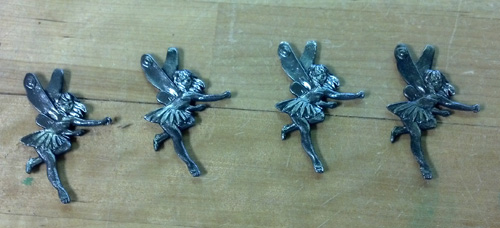Gitty's Bench Notes 4/14/14 - How our Custom Sound-hole Covers are Made - Part 1

Phase 1: Casting the Pewter
- We hand-cast our pewter parts from modern lead-free using special molds. Some of the molds we make ourselves and others we buy from commercial sources.
- These parts are cast one at a time, by hand. No high-tech automated stuff here. Due to how thin the molds are, about half the time you don't get a complete casting, so there is a lot of re-melting of incomplete parts.
- Casting pewter can be dangerous (since it has to be heated to about 575 degrees F to melt), and pouring a stream of it over your finger really, really hurts (learned the hard way). So being careful is important.
- Once cast, the parts are cleaned up, buffed on a wire wheel and then soaked in a blackening chemical bath for a few minutes.
- Once the blackening is carefully buffed off the higher points, the piece is ready for use. Leaving the blackening in the low points gives the pewter piece that special antiqued look prized in old pewter pieces.
Phase 2: Milling the thin wood stock

We buy large slabs of African mahogany that are 3 or 4 inches thick, 8 to 12 inches wide and 8-12 feet in length.
The large boards are cut into shorter lengths to make them easier to resaw and handle.
- The large timbers are then resawn on our big 17" bandsaw, using a 1" thick 3-teeth-per-inch bi-metal resaw blade. These blades are not cheap!
- We then plane the panels down to the thinnest our planer will go (a little over 3/16"), and finish it on the drum sander to give at least one side a nice smooth surface with a thickness of just under 3/16".
- The long panels are then cut down to the size that fits our special CNC router jig.
We'll cover the remaining steps of the process, including the CNC cutting and finishing process, in a separate post in a few days. Stay tuned!
Recent Posts
-
2024 World's Wildest Electric Cigar Box Guitar Build-Off Winners!!!
C. B. Gitty Crafter Supply is proud to announce the winners of the 2024 "World's Wildest Electric Ci …31st Oct 2024 -
Improved C. B. Gitty: Easier Than Ever! (Work in Progress)
Ben “Gitty” has been cleaning house, making our website even easier find your favorite parts, kits a …7th Oct 2024 -
Build-Off Contest 2024: The World's Wildest ELECTRIC Cigar Box Guitar
CBGitty.com is looking for the WILDEST, LOUDEST & MOST DIABOLICAL electric cigar box guitar ever …6th Sep 2024




